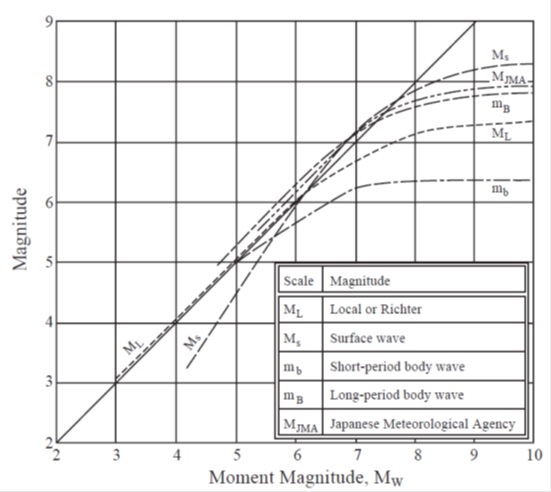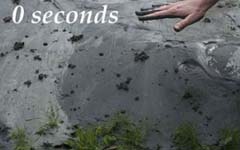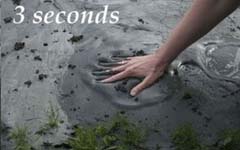(Following paragraphs are cited from
Youd, T. L., and Idriss, I. M., 2001, “Liquefaction Resistance of Soil: Summary Report from the 1996 NCEER and 1998 NCEER/NSF Workshops on Evaluation of Liquefaction Resistance of Soils”, Journal of Geotechnical and Geoenvironmental Engineering, Volume 127, No. 10.)
Earthquake Magnitude
Records from recent earthquakes, such as 1979 Imperial Valley, 1988 Armenia, 1989 Loma Prieta, 1994 Northridge, and 1995 Kobe, indicate that the relationship between duration and magnitude is rather uncertain and that factors other than magnitude also influence duration. For example, unilateral faulting, in which rupture begins at one end of the fault and propagates to the other, usually produces longer shaking duration for a given magnitude than bilateral funding, in which slip begins near the midpoint on the fault and propagates in both directions simultaneously. Duration also generally increases with distance from the seismic energy source and may vary with tectonic province, site conditions, and bedrock topography (basin effects).
Question: Should correction factors be developed to adjust duration of shaking to account for the influence of earthquake source mechanism, fault rupture mode, distance from the energy source, basin effects, etc.?
Answer: Faulting characteristics and variations in shaking duration are difficult to predict in advance of an earthquake event. The influence of distance generally is of secondary importance within the range of distances to which damaging liquefaction effects commonly develop. Basin effects are not yet sufficiently predictable to be adequately accounted for in engineering practice. Thus the workshop participants recommend continued use of the generally conservative relationship between magnitude and duration that is embodied in the simplified procedure.
Question: An important difference between eastern U.S. earthquakes and western U.S. earthquakes is that eastern ground motions are generally richer in high-frequency energy and thus could generate more significant stress cycles and equivalently longer durations than western earthquakes of the same magnitude. Is a correction needed to account for higher frequencies of motions generated by eastern U.S. earthquakes?
Answer: The high-frequency motions of eastern earthquakes are generally limited to near-field rock sites. High-frequency motions attenuate or are damped out rather quickly as they propagate through soil layers. This filtering action reduces the high-frequency energy at soil sites and thus reduces differences in numbers of significant loading cycles. Because liquefaction occurs only within soil strata, duration differences on soil sites between eastern and western earthquakes are not likely to be great. Without more instrumentally recorded data from which differences in ground motion characteristics can be quantified, there is little basis for the development of additional correction factors for eastern localities.
Another difference between eastern and western U.S. earthquakes is that strong ground motions generally propagate to greater distances in the east than in the west. By applying present state-of-the-art procedures for estimating peak ground acceleration at eastern sites, differences in amplitudes of ground motions between western and eastern earthquakes are properly taken into account.
Question: Which magnitude scale should be used for selection of earthquake magnitudes for liquefaction resistance analyses?
Answer: Seismologists commonly calculate earthquake magnitudes using five different scales: (1) local or Richter magnitude ML; (2) surface-wave magnitude Ms; (3) short-period body-wave magnitude mb; (4) long-period body-wave magnitude mB; and (5) moment magnitude Mw. Moment magnitude, the scale most commonly used for engineering applications, is the scale preferred for calculation of liquefaction resistance. As Fig. 16 shows, magnitudes from other scales may be substituted directly for Mw within the following limitations—ML < 6, mB < 7.5, and 6 < Ms < 8—mb, a scale commonly used for eastern U.S. earthquakes, may be used for magnitudes between 5 and 6, provided mb values are corrected to equivalent Mw values. The curves plotted in Fig. 16 may be used for this adjustment (Idriss 1985).

FIG. 16. Relationship between Moment Mw and Other Magnitude Scales (Reproduced from Heaton et al. Unpublished Report, 1982)
Peak Acceleration
In the simplified procedure, peak horizontal acceleration amax is used to characterize the intensity of ground shaking. To provide guidance for estimation of amax, the workshop addressed the following questions.
Question: What procedures are preferred for estimating amax at potentially liquefiable sites?
Answer: The following methods, in order of preference, may be used for estimating amax:
1) The preferred method for estimating amax is through empirical correlations of amax with earthquake magnitude, distance from the seismic energy source, and local site conditions. Several correlations have been published for estimating amax for sites on bedrock or stiff to moderately stiff soils. Preliminary attenuation relationships have also been developed for a limited range of soft soil sites (Idriss 1991). Selection of an attenuation relationship should be based on such factors as region of the country, type of faulting, and site condition.
2) For soft sites and other soil profiles that are not compatible with available attenuation relationships, amax may be estimated from local site response analyses. Computer programs such as SHAKE and DESRA may be used for these calculations (Schnabel et al. 1972; Finn et al. 1977). Input ground motions in the form of recorded accelerograms are preferable to synthetic records. Accelerograms derived from white noise should be avoided. A suite of plausible earthquake records should be used in the analysis, including as many as feasible from earthquakes with similar magnitudes, source distances, etc.
3) The third and least desirable method for estimating peak ground acceleration is through amplification ratios, such as those developed by Idriss (1990, 1991) and Seed et al. (1994). These factors use a multiplier or ratio by which bedrock outcrop motions are amplified to estimate surface motions at soil sites. Because amplification ratios are influenced by strain level, earthquake magnitude, and frequency content, caution and considerable engineering judgment are required in the application of these relationships.
Question: Which peak acceleration should be used: (1) the largest horizontal acceleration recorded on a three-component accelerogram; (2) the geometric mean (square root of the product) of the two maximum horizontal components; or (3) a Vectorial combination of horizontal accelerations?
Answer: According to I. M. Idriss (oral discussion at NCEER workshop, 1996), where recorded motions were available, the larger of the two horizontal peak components of acceleration was used in the compilation of data used to derive the original simplified procedure. Where recorded values were not available, which was the circumstance for most sites, peak acceleration values were estimated from attenuation relationships based on the geometric mean of the two orthogonal peak horizontal accelerations. In nearly all instances where recorded motions were used, the peaks from the two horizontal records were approximately equal. Thus where a single peak was used, the peak and the geometric mean of the two peaks were about the same value. Based on this information, the workshop participants concurred that use of the geometric mean is consistent with the development of the procedure and is preferred for use in engineering practice. However, use of the larger of the two orthogonal peak accelerations yields a larger estimate of amax, is conservative, and is allowable. Vectorial accelerations are seldom calculated and should not be used. Peak vertical accelerations are generally much smaller than peak horizontal accelerations and are ignored for calculation of liquefaction resistance.
Question: Liquefaction usually develops at soil sites where ground motion amplification may occur and where sediment may soften, reducing motions as excess pore pressure develop. How should investigators account for these factors in estimating peak acceleration?
Answer: The recommended procedure is to calculate or estimate the amax that would occur at the site in the absence of increased pore pressure or the onset of liquefaction. That peak acceleration incorporates the influence of site amplification, but neglects the influence of excess pore-water pressure.
Question: Should high-frequency spikes (periods <0.1 s) in acceleration records be considered or ignored?
Answer: In general, short-duration, high-frequency acceleration spikes are too short in duration to generate significant instability or deformation of granular structures, and should be ignored. By using attenuation relationships for estimation of peak acceleration, as noted above, high-frequency spikes are essentially ignored because few high-frequency peaks are incorporated in databases from which attenuation the relationships were derived. Similarly, ground response analyses programs such as SHAKE and DESRA generally attenuate or filter out high-frequency spikes, reducing their influence. Where amplification ratios are used, engineering judgment should be used to determine which bedrock acceleration is to be amplified.









